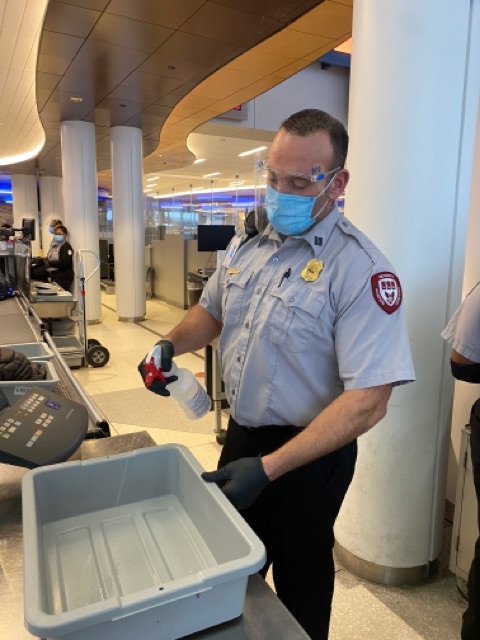 An airport security officer conducts some extra sanitizing of a checkpoint bin at Frederick Douglass Greater Rochester International Airport. (TSA photo)
An airport security officer conducts some extra sanitizing of a checkpoint bin at Frederick Douglass Greater Rochester International Airport. (TSA photo)
ROCHESTER, N.Y. – With Memorial Day Weekend about to kick off, the Transportation Security Administration (TSA) is ready for the expected increase in the number of travelers who will be flying out of Frederick Douglass Greater Rochester International Airport.
“We are prepared to handle the expected increase in travel volume this summer and at the same time TSA is committed to supporting a healthy and secure environment for airline passengers, security personnel and airport employees,” said Bart R. Johnson, TSA’s Federal Security Director for Upstate New York. “For those who will be traveling this summer, travelers need to know that the checkpoint experience will look different to those who have not flown since the start of the pandemic, and individuals flying out of Rochester should be prepared for those changes.”
Nationwide TSA officers are screening approximately 1.6 million people daily, which is a large increase from last year, but still down significantly from 2019, when closer to 2.5 million people were screened daily during the busiest summer days. Due to the increase in the number of travelers since the start of the pandemic, travelers should arrive at the checkpoint 90 minutes before their flight.
Everyone in the airport is required to continue to wear a mask as prescribed by the federal mask mandate when they are in airports, bus and rail stations, as well as while on passenger aircraft, public transportation, passenger railroads, and over-the-road buses operating on scheduled fixed-routes. This means that all travelers must be wearing a mask at TSA airport screening checkpoints and throughout the airport and during their flights. If a traveler does not have a mask, a TSA officer will offer a mask to that individual at the checkpoint
“We have what I call a ‘new normal’ at airport security checkpoints since the start of the pandemic,” Johnson said. Travelers and security officers will be wearing masks and there will be reminders to socially distance posted at the checkpoint. When approaching the travel document checking podium, passengers will see an acrylic barrier that has been installed to reduce opportunities for cross-contamination. Travelers will be asked to remove their masks for a few seconds so that the officer can match the individual’s face to the photo on their ID. Travelers will place their own ID into the credential authentication technology scanner, thus reducing a touchpoint.
Johnson also said that security officers will change their gloves between each pat down and travelers may request that a TSA officer put on a new pair of gloves at any time. TSA officers also will be using a fresh swab for each passenger when testing for possible explosive material.
Security employees will be conducting routine cleaning and disinfecting of frequently touched surfaces and security screening equipment at the checkpoints.
TSA is now allowing travelers to bring one liquid hand sanitizer container up to 12 ounces per passenger in carry-on bags until further notice. Passengers can expect that these containers larger than the standard allowance of 3.4 ounces of liquids permitted through a checkpoint will need to be screened separately, which will add some time to their checkpoint experience. Travelers also are permitted to bring individually packaged alcohol or anti-bacterial wipes in carry-on or checked luggage.
To reduce touchpoints, it is recommended that travelers place items from their pockets such as wallets, keys, lip balm, tissues and cell phones into their carry-on bags to be screened instead of putting items from their pockets directly into bins. This minimizes the placing of personal items in a bin that you might hold to your face such as lip balm, tissues and cell phones. It also reduces the chance that travelers will leave something behind in a bin.
Individuals who are planning to travel this summer should consider enrolling in TSA PreCheck®. The popular expedited screening program allows travelers to leave on their shoes, jackets, belts and enables them to keep their electronics and 3-1-1 bags in their carry-on bags. TSA PreCheck® membership is more valuable now than ever before because it reduces touchpoints during the pandemic and puts travelers in security lines that have fewer travelers and move quicker, which encourages social distancing.
Travelers also need to know what can and cannot go in their carry-on bag from firearms to oversize liquids. It is important to know what items should not be packed in a carry-on bag because if a carry-on bag triggers an alarm, it will require a TSA officer to open the bag to resolve the alarm. This means that a TSA officer will have to open your baggage and go inside to identify what item may have caused the alarm. Remember, it’s vital to reduce touchpoints during a pandemic, so be sure not to pack any prohibited items. Unsure if an item should be packed in a carry-on bag, checked bag, either or neither? Download the free myTSA app, which has a handy “What can I bring?” feature that allows you to type in the item to find out if it can fly. Or ask us on Twitter or Facebook Messenger at @AskTSA.
